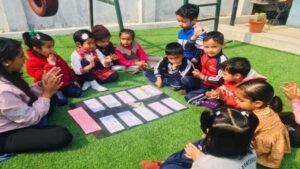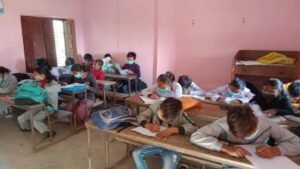Education is a fundamental part of any society. In Nepal it plays a crucial role in shaping the future of the country. Let’s take a closer look at how the education system in Nepal works, from the beginning of school life to higher education.
1.Early Childhood Education
Education in Nepal begins early. Children start their formal education at around age 5 or 6. The initial phase is known as Primary School, which covers grades 1 through 5. Primary education is essential as it provides basic literacy and numeracy skills. In rural areas, access to quality primary education can be challenging due to limited resources.

2.Secondary Education
After completing primary school, students move on to Secondary School, which consists of grades 6 through 10. This stage is divided into two parts:
- Lower Secondary: Grades 6 to 8
- Upper Secondary: Grades 9 and 10
In secondary school, students start to learn more subjects, including science, social studies, and mathematics. At the end of grade 10, students take the School Leaving Certificate (SLC) exams. Passing these exams is crucial as it determines whether students can continue to higher education.

3.Higher Secondary Education
Students who pass the SLC exams can move on to Higher Secondary Education, which includes grades 11 and 12. This stage is also known as +2 and offers a variety of streams like Science, Management, and Humanities. This phase is important for students as it helps them choose their future career paths and prepares them for higher education or vocational training.
4.Higher Education
After completing higher secondary education, students can pursue Higher Education. This includes undergraduate and postgraduate studies. Nepal has several universities offering a range of programs in fields such as engineering, medicine, business, and arts. Some of the prominent universities include Tribhuvan University, Kathmandu University, and Pokhara University.
Challenges and Developments In Education System Of Nepal

The education system in Nepal faces several challenges. One of the main issues is the disparity between urban and rural areas. In cities, schools often have better facilities and resources compared to rural areas where schools may lack basic amenities. Additionally, the quality of education can vary widely.
Despite these challenges, there have been efforts to improve the education system. The government has introduced policies to increase literacy rates and enhance the quality of education. There are also numerous non-governmental organizations working to support education in remote areas.
The Role of Technology In Education System Of Nepal
Technology is slowly making its way into Nepal’s education system. With the rise of digital tools and online learning platforms, students and teachers are beginning to benefit from new ways of teaching and learning. However, access to technology is still limited in some areas.
Conclusion
The education system in Nepal is evolving, and there is a strong focus on improving access and quality. While there are challenges to overcome, the commitment to education is evident. By addressing these challenges and embracing new opportunities, Nepal is working towards a brighter future for its students and the country as a whole.

![setopati.com logo {"remix_data":[],"remix_entry_point":"challenges","source_tags":["local"],"origin":"unknown","total_draw_time":0,"total_draw_actions":0,"layers_used":0,"brushes_used":0,"photos_added":0,"total_editor_actions":{},"tools_used":{"transform":1},"is_sticker":false,"edited_since_last_sticker_save":true,"containsFTESticker":false}](https://setopatimedia.com/wp-content/uploads/2024/08/setopati.com-logo.jpg)
